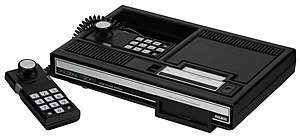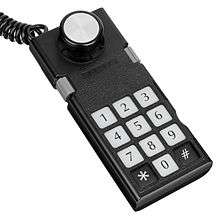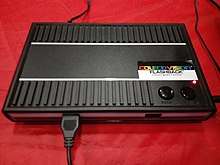ColecoVision
The ColecoVision is Coleco Industries' second-generation home video-game console that was released in August 1982. The ColecoVision offered a closer experience to more powerful arcade game systems, compared to competitors such as the Atari 2600 and Atari 5200, along with the means to expand the system's basic hardware.
 | |
 A ColecoVision unit | |
| Manufacturer | Coleco Industries, Inc. |
|---|---|
| Type | Home video game console |
| Generation | Second generation |
| Release date |
|
| Discontinued | 1985 |
| Units sold | over 2 million (1982-83)[1] |
| Media | ROM cartridge |
| CPU | Zilog Z80 |
| Memory | 1 kB scratchpad RAM 16 kB video RAM 8kB ROM |
| Storage | 8/16/24/32 KB |
| Graphics | TMS9928A (NTSC) / TMS9929A (PAL) |
| Sound | SN76489 |
| Controller input | Joystick/Numeric Keypad Roller Controller Driving Controller Super Action Controller |
| Best-selling game | Donkey Kong (pack-in) |
| Predecessor | Telstar series (1978) |
The initial catalog of twelve games included Nintendo's Donkey Kong as the pack-in cartridge, Sega's Zaxxon, and some lesser known arcade titles that found a larger audience on the console, such as Lady Bug, Cosmic Avenger, and Venture. Approximately 145 titles in total were published as ROM cartridges for the system between 1982 and 1984.[2] Coleco released a series of hardware add-ons and special controllers to expand the capabilities of the console.
The ColecoVision was discontinued in 1985 when Coleco withdrew from the video game market.
History
By Christmas of 1982, Coleco had sold more than 500,000 units,[3][4] in part on the strength of Donkey Kong as its bundled game.[5] ColecoVision's main competitor was the less commercially successful Atari 5200[6][7][8] which used the same custom graphics and sound chips developed for the Atari 8-bit family of computers launched in 1979.
The ColecoVision was distributed by CBS Electronics outside of North America, and was branded the CBS ColecoVision. In Europe the console was released in July 1983, nearly one year after the North American release.[9]
Sales quickly passed 1 million in early 1983,[10] before the video game crash of 1983. By the beginning of 1984, quarterly sales of the ColecoVision had dramatically decreased.[11]
Over the next 18 months, the Coleco company ramped down its video game division, ultimately withdrawing from the video game market by the end of the summer of 1985.[12][13] The ColecoVision was officially discontinued by October 1985.[14] Total sales of the ColecoVision are uncertain but were ultimately in excess of 2 million units,[15][16][17][18] due to the console continuing to sell modestly up until its discontinuation the following year.[19] The video game crash of 1983 has been cited as the main cause of the ColecoVision's being discontinued less than three years after its launch.[20]
In 1983, Spectravideo announced the SV-603 ColecoVision Video Game Adapter for its SV-318 computer. The company stated that the $70 product allowed users to "enjoy the entire library of exciting ColecoVision video-game cartridges".[21]
Hardware

On NTSC ColecoVision consoles, all first-party cartridges and most third-party software titles feature a 12.7 second pause before presenting the game select screen.[22] CBS Electronics reduced this pause in the BIOS to 3.3 seconds for their PAL and SECAM ColecoVision consoles.[23]
Expansion Modules and accessories
From its introduction, Coleco touted the ColecoVision's hardware expandability by highlighting the Expansion Module Interface on the front of the unit. These hardware expansion modules and accessories were sold separately.


Atari 2600 expansion
Expansion Module #1 makes the ColecoVision compatible with Atari 2600 cartridges and controllers.[22] Functionally, this gave the ColecoVision the largest software library of any console of its day. The expansion module prompted legal action from Atari. Coleco and Atari settled out of court with Coleco becoming licensed under Atari's patents. The royalty based license also applied to Coleco's Gemini game system, a stand-alone clone of the 2600.[24]
Driving controller
Expansion Module #2 is a driving controller (steering wheel / gas pedal) that came packaged with the cartridge Turbo. The gas pedal is merely a simple on/off switch.[25] Although Coleco called the driving controller an expansion module, it actually plugs into the controller port, not the Expansion Module Interface.[26] The driving controller is also compatible with the cartridges Destructor, Bump 'n' Jump, Pitstop, and The Dukes of Hazzard.
Adam computer expansion
Expansion Module #3 converts the ColecoVision into the Adam computer, complete with keyboard, digital data pack (DDP) cassette drive, 64 kB RAM, and printer.
Roller Controller
The Roller Controller is a trackball that came packaged with the cartridge Slither, a conversion of the arcade game.[27][28] The roller controller uses a special power connector that is not compatible with Expansion Module #3 (the Adam computer). Coleco mailed an adapter to owners of both units who complained.[29] The other cartridge programmed to use the roller controller is Victory. A joystick mode switch on the roller controller allows it to be used with all cartridges including WarGames, Omega Race, and Atarisoft's Centipede.
Super Action Controller
The Super Action Controller Set is a set of two handheld joystick controllers that came packaged with the cartridge Super Action Baseball. Each controller has a ball-top joystick, four finger triggered action buttons, a 12-button numeric keypad, and a "speed roller".[30] The cartridges Super Action Football, Rocky Super Action Boxing, and a conversion of the arcade game Front Line are also designed to be used with the Super Action Controller.
Unreleased
Expansion Module #3 was originally the Super Game Module. It was advertised for an August 1983 release but was ultimately cancelled and replaced with the Adam computer expansion. The Super Game Module added a tape drive known as the Exatron Stringy Floppy with 128KB capacity, and the additional RAM, said to be 30KB,[31] to load and execute programs from tape. Games could be distributed on tiny tapes, called wafers, and be much larger than the 16KB or 32KB ROM cartridges of the day. Super Donkey Kong, with all screens and animations, Super Donkey Kong Jr, and Super Smurf Rescue were demonstrated with the Super Game Module. The Adam computer expansion with its 256KB tape drive and 64KB RAM fulfilled the specifications promised by the Super Game Module.[32][33]
Games
Legacy

During the creation of the Nintendo Entertainment System, the ColecoVision was a huge influence. Takao Sawano, chief manager of the project, brought a ColecoVision home to his family, who were impressed by the system's capability to produce smooth graphics, which contrasted with the flickering commonly seen on Atari 2600 games. Masayuki Uemura, head of Famicom development, stated that the ColecoVision set the bar that influenced how he approached the creation of the Famicom.[34]
In 1986, Bit Corporation produced a ColecoVision clone called the Dina, which was sold in the United States by Telegames as the Telegames Personal Arcade.[35]
IGN named the ColecoVision their 12th-best video-game console out of their list of 25, citing "its incredible accuracy in bringing current-generation arcade hits home."[36]
In 1996, programmer Kevin Horton released the first homebrew game for the ColecoVision, a Tetris clone entitled Kevtris.[37][38]
In 1997, Telegames released Personal Arcade Vol. 1, a collection of ColecoVision games for Microsoft Windows,[39] and a 1998 follow-up, Colecovision Hits Volume One.[40]
In 2012, Opcode Games released their own Super Game Module expansion, which increases RAM from 16KB to 32KB and adds four additional sound channels.[41] This expansion brings the ColecoVision close to the MSX architecture standard, allowing MSX software to be more easily ported.
In 2014, AtGames began producing the ColecoVision Flashback console that includes 60 games, but not the original pack-in game, Donkey Kong.[42]
References
- "Coleco Industries, Inc. 1983 Annual Report". Coleco Industries, Inc. 1983: 3.
The year's sales of 1.5 million ColecoVision units brought the installed base to over 2 million units worldwide.
Cite journal requires|journal=(help) - Forster, Winnie (2005), The encyclopedia of consoles, handhelds & home computers 1972 - 2005, GAMEPLAN, p. 50, ISBN 3-00-015359-4
- "Coleco hits with home video games", Business Week: 31, 1983-01-24,
Most of 1982's action was in the second half, when Coleco shipped 550,000 ColecoVision game machines--which sell for $169 to $189--booking orders for nearly that many more.
- Video Game Maker Says 1st-Quarter Profit More Than Tripled, Associated Press, 1983-04-20,
Arnold C. Greenberg, Coleco's president and chief executive, said more than 500,000 ColecoVision players were shipped during the first quarter, nearly equaling the number shipped in all of 1982.
- "Coleco's New Video Challenge", New York Times: 1 (Section D), 1982-11-11,
Potential Colecovision buyers have also apparently been attracted by Coleco's licensing agreement with Nintendo Inc., the Japanese creator of Donkey Kong, a current arcade hit, and Universal City Studios Inc. One Donkey Kong cartridge comes with each Colecovision unit.
- Aeppel, Timothy (1982-12-10), "Zap! Pow! Video games sparkle in holiday market", Christian Science Monitor: 7,
In recent weeks, two particularly hot-selling systems have emerged - the Atari 5200 and ColecoVision. Both are described as powerful 'third wave' machines, the Cadillacs of game systems, and priced accordingly at close to $200...[T]hey are sure to snatch most of the Christmas market.
- Harmetz, Aljean (1984-01-10), "Sigh of Relief on Video Games", New York Times: 1 (Section D),
As for game hardware, many experts said that Atari's...5200 or Coleco's Colecovision would corner the high end.
- "Coleco Strong In Marketing", New York Times, 1983-08-01,
Since its introduction last fall, Colecovision has sold about 1.4 million units...Of that total, about 900,000 were sold this year, compared with 800,000 units by Atari and 300,000 by Mattel.
- "Delpher Kranten - Limburgsch dagblad 31-12-1983". Delpher.nl. 1983-12-31. Retrieved 2019-07-23.
- Video Game Maker Says 1st-Quarter Profit More Than Tripled, 1983-04-20
- Coleco Industries sales report, PR Newswire, 1984-04-17,
'First quarter sales of ColecoVision were substantial, although much less that [sic] those for the year ago quarter,' Greenberg said in a prepared statement. He said the company has sold 2 million ColecoVision games since its introduction in 1982.
- "Coleco Reassesses Its Video Games", New York Times, Reuters: 4 (Section D), 1985-06-13,
Coleco Industries is assessing its continuing commitment to the video game business...Arnold C. Greenberg, the chief executive, said no timetable had been set for a decision on continuing or dropping the Colecovision products or on whether the software for the games would continue to be produced if hardware production was discontinued.
- "Video games Coleco may drop out", The Globe and Mail (Canada), 1985-06-21,
Coleco Industries Inc. of West Hartford, Conn., is considering withdrawal from the video game business in both hardware and software.
- "Coleco's Net In Sharp Rise", New York Times, Associated Press, 1985-10-19,
Thursday, Coleco said the entire inventory of its troubled Adam personal computer has been sold, along with much of its Colecovision inventory. The company's chairman, Arnold Greenberg, said Coleco expects no more charges against earnings from the two discontinued products.
- "Coleco Industries, Inc. 1984 Annual Report". Coleco Industries, Inc. 1984: 2.
Sales in the Consumer Electronics segment were $98.6 million in 1984
Cite journal requires|journal=(help) - "Coleco Industries, Inc. 1984 Annual Report". Coleco Industries, Inc. 1984: 22.
The decline in sales of Consumer Electronics was primarily due to reduced sales of ColecoVision products. The increase in shipments of the ADAM Family Computer System in 1984 was largely offset by provisions for price reductions and returns recorded in the last half of the year.
Cite journal requires|journal=(help) - "Coleco Industries, Inc. 1984 Annual Report". Coleco Industries, Inc. 1984: 3.
the total of ColecoVision inventory and accounts receivable was $40.5 million at December 31, 1984. During 1985 it is expected that accounts receivable will be converted to cash and the balance of ColecoVision inventory sold.
Cite journal requires|journal=(help) - "Coleco Industries, Inc. 1985 Annual Report". Coleco Industries, Inc. 1985: 25.
Consumer Electronics net sales of $56.2 million consisted principally of the ADAM Family Computer and ColecoVision video game systems, accessories and software.
Cite journal requires|journal=(help) - Kleinfield, N. R. (1985-07-21), "Coleco Moves Out Of The Cabbage Patch", New York Times: 4 (Section 3),
Coleco is now debating whether to withdraw from electronics altogether. Colecovision still sells, but it is a shadow of its former self.
- "The Next Generation 1996 Lexicon A to Z: ColecoVision". Next Generation. No. 15. Imagine Media. March 1996. p. 31.
- "Heavy Hardware". Softline. March 1983. p. 46. Retrieved 28 July 2014.
- The Game Doctor (June 1983). "Q&A". Electronic Games. p. 112. Retrieved 7 January 2015.
- "Game Title Display Duration Analysis". AtariAge. Retrieved 6 November 2019.
- "Atari-Coleco Pact". the New York Times. the New York Times.
- "Coleco ColecoVision Expansion Module No. 2 Driving Controller Disassembled". The-liberator.net. Retrieved 2014-05-27.
- "Expansion Module #2 Operation Manual" (PDF). Retrieved 2019-07-23.
- "Controller Update: Probing the World of the Exotic". Electronic Games. June 1983. pp. 24–28. Retrieved 6 January 2015.
- Classic Game Room reviews COLECOVISION ROLLER CONTROLLER (YouTube) (YouTube). Lord Karnage. 2008. Event occurs at 4:45. Retrieved April 2, 2014.
- "Roller Controller Operation Manual" (PDF). Retrieved 2019-07-23.
- "Super Action Controller Set Operation Manual" (PDF). Retrieved 2019-07-23.
- "The First ColecoVision SGM. Super Game Module 1983. (never released)". www.colecovision.dk.
- Brown, William (June 1983). "Super Game Module: Million bit baby". Electronic Fun with Computer Games. 1 (8): 16, 17, 39–43, 94.
- writer, D. S. Cohen A. gaming; developer; teacher; Historian, Video Game; Professional, Gaming Industry. "The ColecoVision/Nintendo Partnership and the Atari Clone". Lifewire.
- "GlitterBerri's Game Translations » Deciding on the Specs". Glitterberri.com.
- "ColecoVision - 1982-1984 - Classic Gaming". Classicgaming.gamespy.com. Archived from the original on 2011-10-01. Retrieved 2010-12-20.
- "Colecovision is number 12". IGN. Retrieved 2010-12-20.
- "Kevtris for ColecoVision". MobyGames. 2006-11-29. Retrieved 2009-08-24.
- "Classic Videogame Games INTERVIEW - Kevin Horton". Good Deal Games. Retrieved 2009-08-24.
- "Personal Arcade Volume One for Windows". MobyGames. 2000-05-21. Retrieved 2009-08-24.
- "Classic Gamer: Colecovision Hits Volume One for Windows". MobyGames. 2000-05-30. Retrieved 2009-08-24.
- "ColecoVision Super Game Module". www.opcodegames.com.
- "ColecoVision Flashback at AtGames E-Store". Archived from the original on 2015-02-15. Retrieved 2015-03-08.
External links
| Wikimedia Commons has media related to ColecoVision. |
- - History of the ColecoVision at Lifewire.
- ColecoVision Zone - Comprehensive archive of photos and documents.